UA9BA hybrids of LPDA and Yagi Udas and other practical examples of multiband antennas
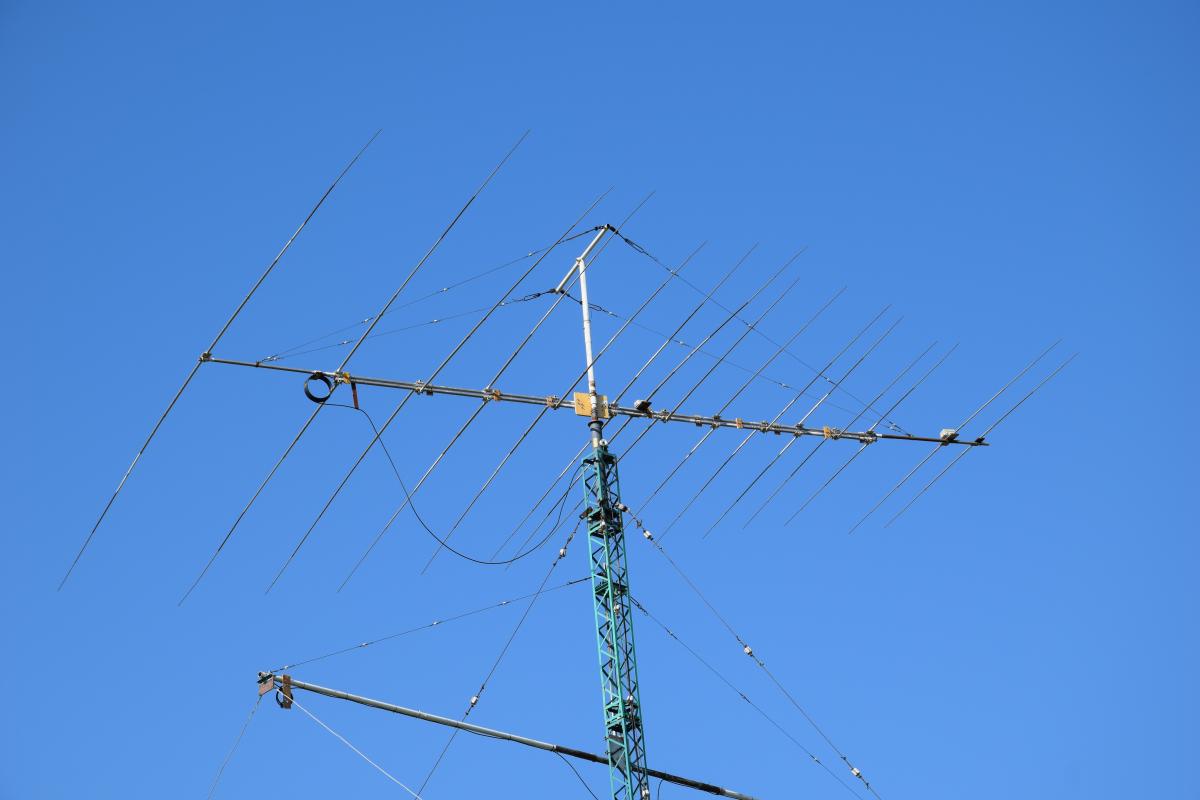
In this article I want to share with you practical results of building LPDAs of different types. I will reveal some of my MMANA based antenna files for your own use and further evaluation and improvements of the models. There are few know-hows in those models but I am sharing them with you for one reason - I decided that the time to share my knowledge with a larger group of people has come, I no longer want to keep it just for my own use. I hope these know-hows will help you make your antennas more efficient.
INTRODUCTION
It has been for most of my conscious amateur radio life that I was interested in Log-Periodics. My first LPDA project was student's work in 1976 on practical and theoretical issues of building narrow banded Log-Yagis. My work was partialy based on materials from article in Nov. 1973 issue of QST mag. by Peter Rhodes K4EWG on Log-Yagi for 20m band. The magazine was available in the Chelyabinsk Polytechnic Institute's technical library. That's the Institute that UK9AAN belonged to. I and my teammates built an 8 element 20 meter band Log-Yagi with 4 element log-cell, 3 parasitic directors and 1 reflector in 1978. It performed very well. Once I graduated from the Institute I was involved for some 8 years in a research work that was not in the RF field, then the Perestroika took us by surprise with the total collapse of the soviet system as the result and then the wild 90's took its place. So, for some 15 years my mind was occupied with matters of surviving of my family with 2 children on our hands rather than LPA's and its features. Thanks God, we've survived and now I can even afford devoting some time to my hobby within the hobby - building antennas of my own design.
IMPLEMENTING PASSIVE ELEMENTS INTO LPDA STRUCTURE
I will illustrate the effect of implementing passive elements with the oldest MMANA based project of mine dated March the 28th of 2008 (there were other projects done in different SW products dated late 90s early 2000s but I lost'em with the crush of an HDD). This antenna consists of 7 meters long 11 element LPDA cell covering one octave of frequencies from 14 to 29 MHz with 4 passive elements (parasites) enhancing the LPDA's performance on 20, 15 and 10 meter amateur bands. Adding passive elements extends the boom length to 10.2 meters. The overall view of the antenna can be seen on Fig.1.
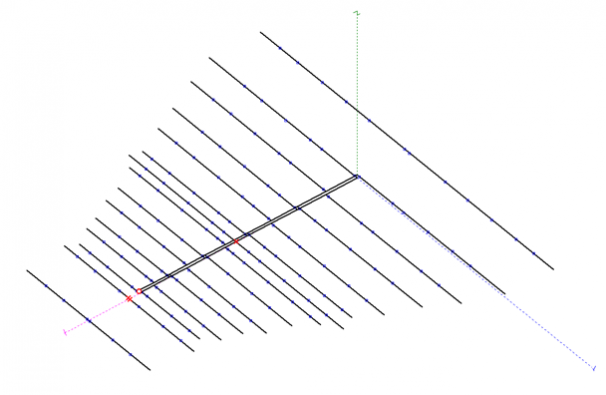
Fig.1
The three parasites can clearly be seen on the picture - two directors and one reflector. Where is the 4th one? The 4th parasitic element is right in the middle of the LPDA cell with red asterisk in the middle of the element. Those that are familiar with MMANA know that the asterisk marks the place of a load. As one can see there are two asterisks in the middle of the closest to the feed point parasitic element - director for 15 meter band - and one in the 4th parasite - 20m band director. Why load those elements? The loads are parallel resonance LC circuits. These circuits detune loaded elements on higher bands, in such way that the elements don't destroy the patterns when the antenna is activated on those higher bands and yet the parasite acts as a director on its own band. So, in this antenna we have one director for 10 m (the front element), one director for 15 m band with two parallel resonance LC circuits connected in series with each other in the middle of the element. One LC circuit is tuned to 26.000 MHz and the other to 29.600 MHz. Say, we place this element in front of LPDA cell without those LC circuits, then the 15 m director would act as a reflector on higher than 22 MHz frequencies, thus completely destroying the performance of LPDA on 12 and 10 meter bands. The one in the middle of log cell acts as a 20 m band director with parallel LC circuit resonating on 19.000 MHz taking good care of 17 m band performance of the antenna. The rear passive element is tuned as a 20m reflector and needs no additional treatment since it acts as a reflector for all frequencies from 14 through 29 MHz. Name of the MMANA file for this antenna is "LPDA realistic design + parasites" see it in the end of article. The name is original as I named it 12 years ago. 5 band central frequency figures of Impedances, VSWR for 100 Ohm feed line, Gain, F/B and elevation angles with antenna height of 30 m over average ground ( dielectric const. of 7, conductivity of 5 mS/m) on lines 1,2,3,4,5 can be seen on Fig.2. as well as those parameters in free space in lines 6,7,8,9,10.

Fig. 2
Examples of computer model Azimuth pattern when over ground at 30 meters and in free space are shown down below in Figures 3 and 4 respectively.
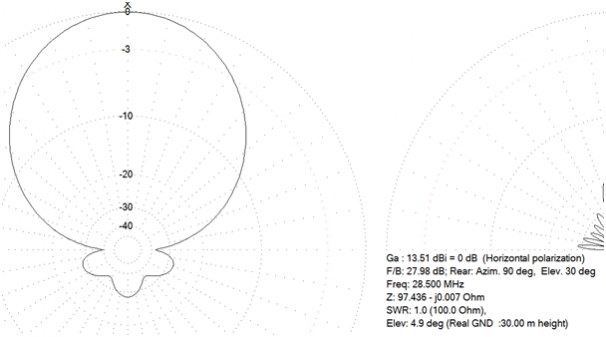
Fig. 3
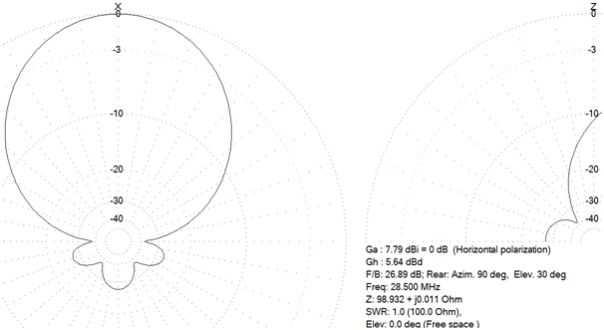
Fig. 4
Examples of computer model Azimuth pattern when over ground at 30 meters and in free space are shown down below in Figures 3 and 4 respectively.
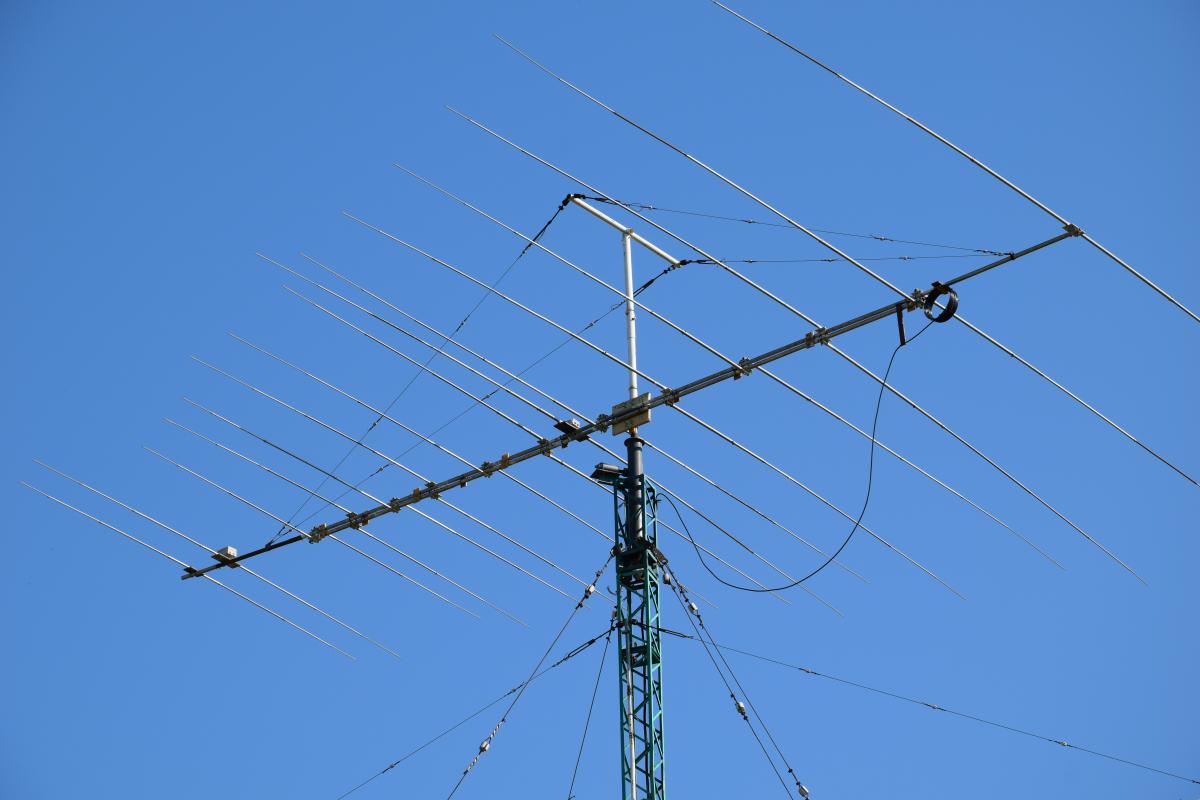 Fig.5
Fig.5

Fig. 6
One might wonder how this sort of hybrid compares with the pure LPDA array of similar dimensions. I will answer this with two more pictures. The layout of an LPDA on same 10.2 meter long boom is shown on Fig.7. One can refer to MMANA file named

Fig. 7
"lpda realistic design 0.88 75 Ohm 10.2 m boom.maa" in the end of article.
The Gain, F/B and other numbers are contained in 5 upper lines - 11, 12, 13, 14 and 15 in Fig.8. The biggest difference with hybrid LPDA is on three bands where I had added specific parasitic elements - a reflector and director on 20m, a director on 15 meters and a director on 10 meters. Adding those elements resulted in higher Gain (roughly +0.5 dB) and higher F/B numbers on those 3 bands.
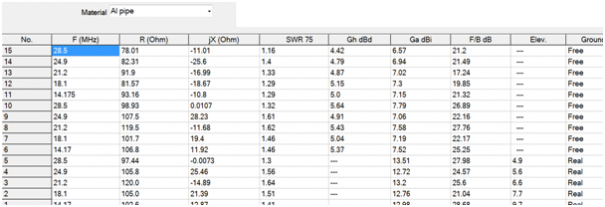
Fig.9
One more solution to a better use of given boom length of 10.2 meters would be LPDA with just 3 passive directors (without 20 m reflector). See Fig.10.

Fig. 10
One can compare the performance of these two antennas shown in Fig.1 and Fig.10 by comparing numbers shown in the table in Fig.11. The 5 bottom lines represent Free Space performance of antenna in Fig.1 - a hybrid with 3 directors and 20m reflector, the 5 upper lines are for the antenna shown in Fig.10 - a hybrid without 20 m reflector. Both antennas are on 10.2 meter long boom. MMANA file for the antenna in Fig.10 is named "LPDA realistic design + PARASITES without 20 m reflector.maa".
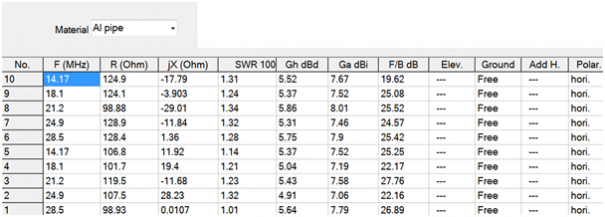
Fig. 11
As one can see the Gain of the hybrid without 20m reflector is higher on all 5 bands of interest but at a cost of poorer F/B on 20 meter band. The choice between the two is a matter of personal preferences.
Another practical example of LPDA antenna materialized by Kostya RT9M in Omsk city is shown on Fig.12.
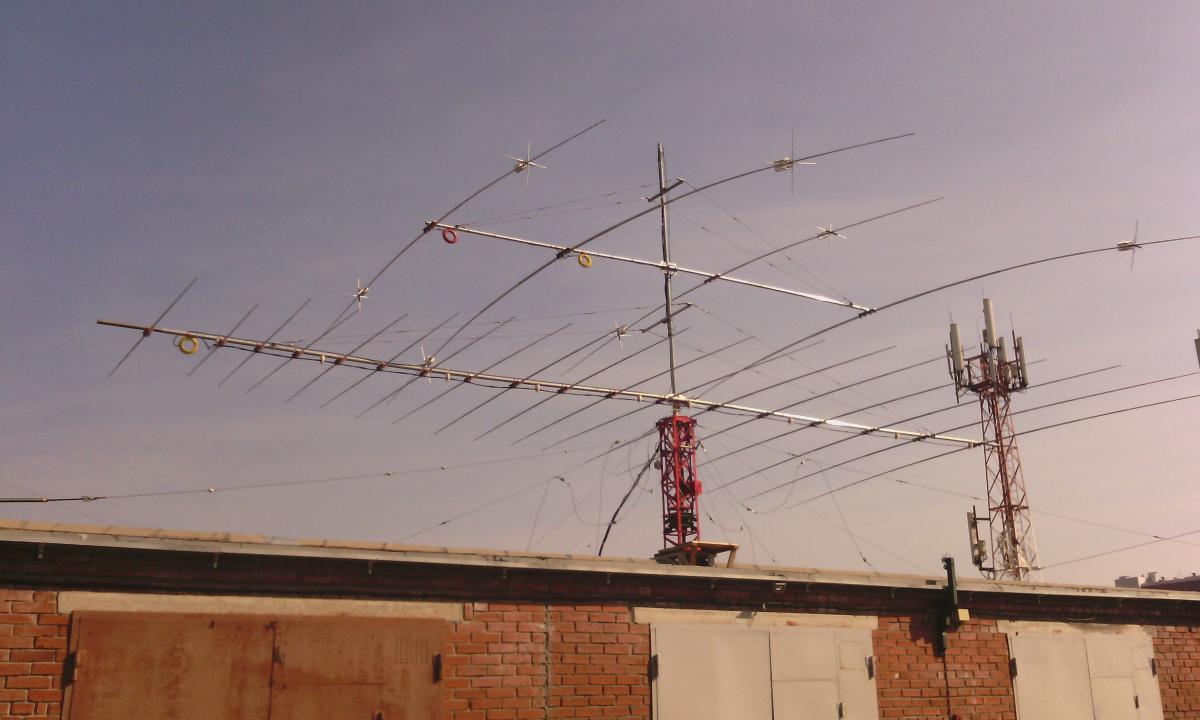 Fig. 12
Fig. 12
The MMANA layout of the antenna shown in Fig.13.
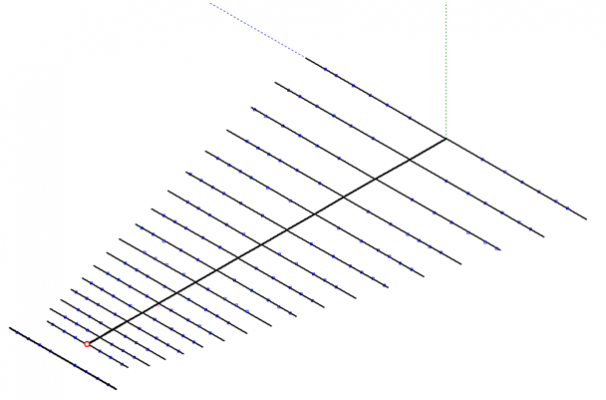
Fig. 13
Central frequency HF amateur radio bands MMANA generated azimuth patterns of the antenna at 30 meters above average ground are shown down below.
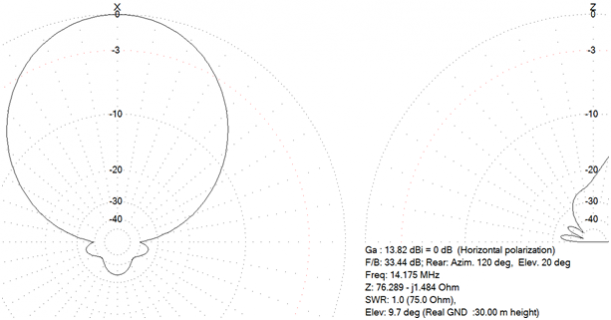
Fig.14 20m Band
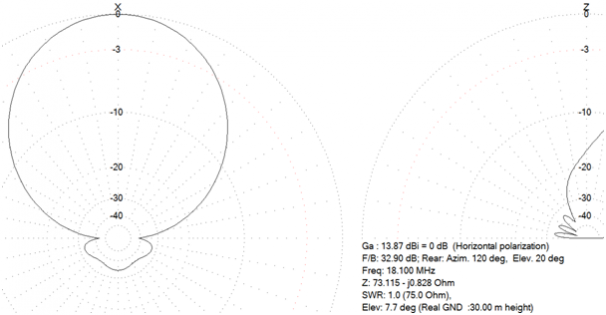
Fig. 15 17m Band
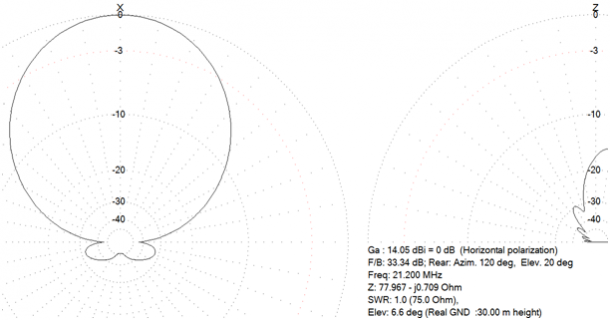
Fig16. 15m Band
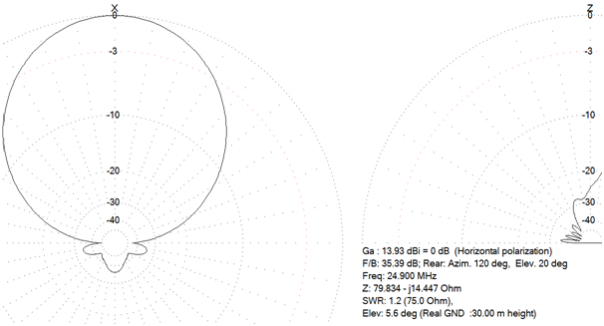
Fig17. 12m Band
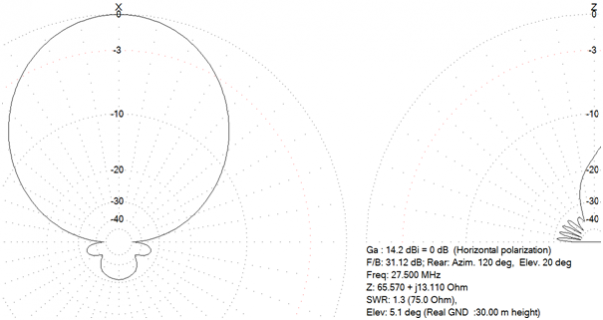
Fig. 18 Citizen Band

Fig.19 10m Band
The table for the Impedance, VSWR (75 Ohm feed line), Gain, F/B is shown in Fig.20. The file name for this model is "RT9M LPDA on 15.9 m boom tapered elements.maa".

Fig.20
ECONOMY CLASS LPDAs (or WIRES &TUBES)
There is a demand for lightweight low profile multiband antennas. One of my designs was duplicated by few amateurs and it works just as modeled. One of the samples is installed at UP2L and its picture is shown on Fig.21.
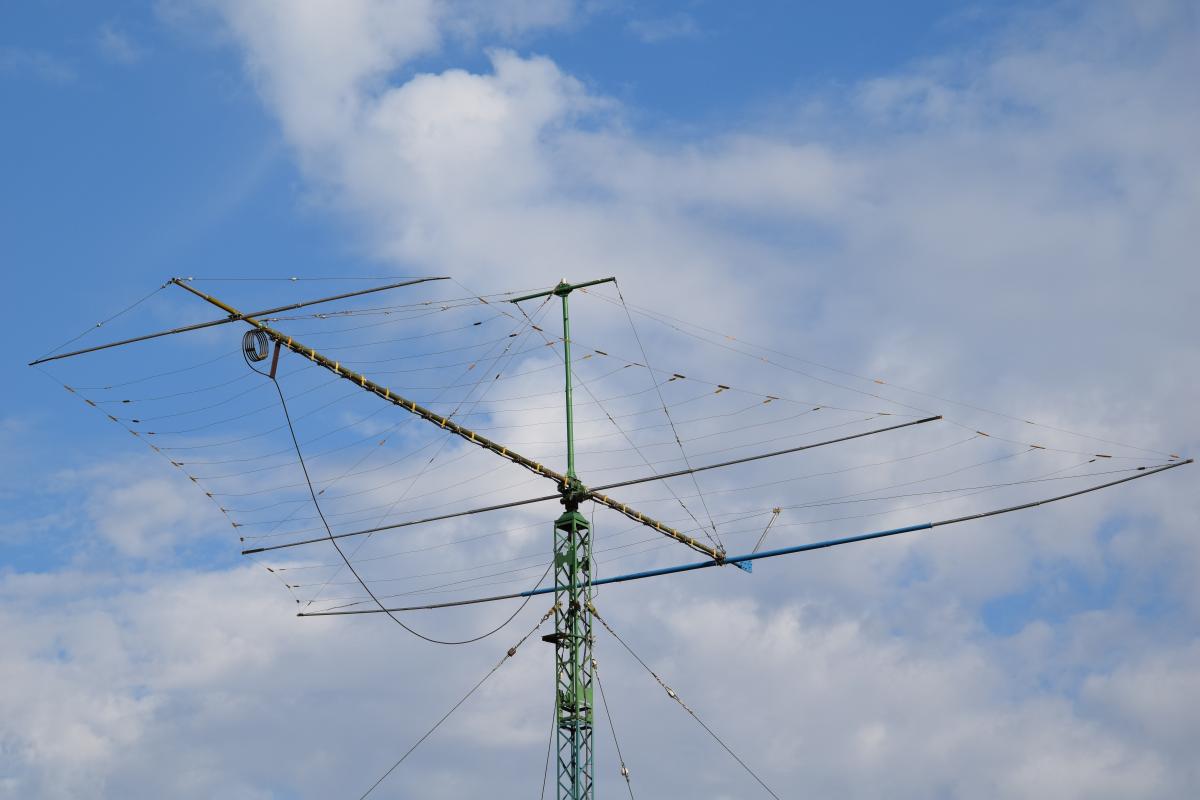 Fig21 UP2L 5 Band wire and tube LPDA
Fig21 UP2L 5 Band wire and tube LPDA
The MMANA layout of the antenna is shown on Fig.22.
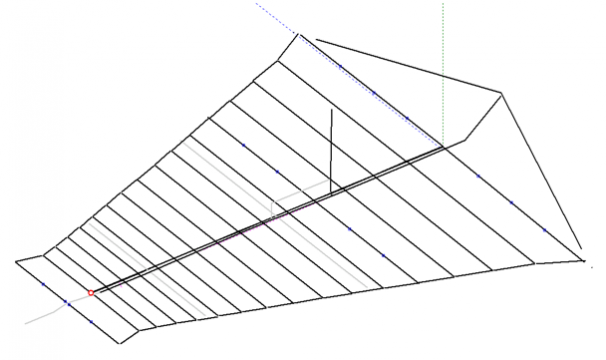
Fig. 22
No stubbed elements in this low budget model, but one passive 10m band director and a wire 20m reflector serving also as a guy wire for the tubular rear element of the log cell are included. There are 3 fish bone tubular elements that are carrying the rest of antenna which mainly consists of wire elements. As one can see from the photograph of the antenna all 3 tubular elements are guy wired in such a way that if extra ice loaded the tubular elements would still be in horizontal position not leaning down under extra weight of icy wire elements. The MMANA model includes the copper wire leer elements that help keeping the cold ends of wire elements in its place as model dictates. The x-axis projection of the antenna is 13.16 meters long. The performance of the antenna can be seen in the table of Fig.23
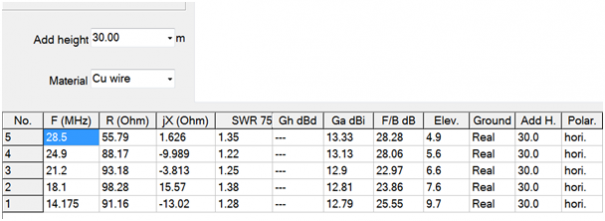
Fig.23
One can note that with the overall length of the antenna 3 meters longer than that of an all tube models in preceding chapter the numbers are kind of on a low side. That's true - they are noticeably lower, than one would expect. That is because of wires instead of thick tapered tubes. I did research on this matter and the conclusion is simple - one loses about 0.4 to 0.6 dB when going from thick tubular elements to thin wires. Even if a 200 Ohm line is in use and OD of wires is 4 mm we still lose about 0.2-0.4 dB of Gain and the F/B numbers suffer too. The MMANA file for this model is named " all wires 20 through 10 m more+ realistic construction 75 Ohm Impedance enhenced 20.maa". For those that like to do their own research I included a MMANA file for the 15.85 meter long boom with 200 Ohm feeding line and thick 4 mm OD copper wires. See its layout in Fig.24.
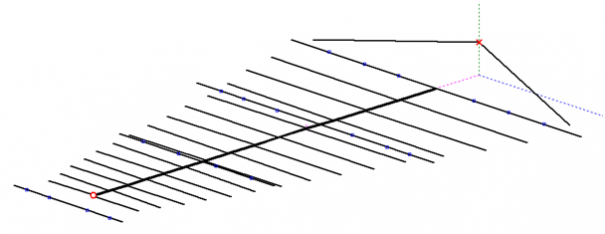
Fig. 24
The performance numbers are in the table in Fig.25. You can compare it to those of all tube ant of RT9M on the same length boom shown in Fig.20. MMANA name for this model is " all wires 5-band lpda 200 ohm 15,85m boom non stubbed parasites.maa".
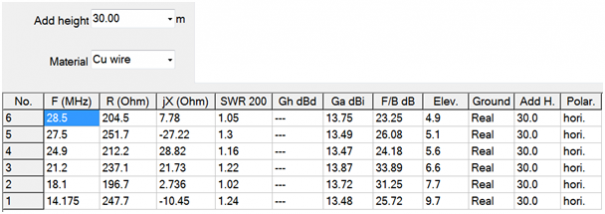
Fig. 25
THE TRUE LPDA & YAGI-UDA HYBRIDS
In this model the true HYBRID of LPDA and YAGI-UDA types is presented. The 40m through 10m antenna on 17.6m long boom is shown in Fig.26. We have here a combined WIRES & TUBES style of antenna construction. The most interesting feature of this model is a jump from LPDA structure into YAGI-UDA structure in the rear part of the antenna. In other words I feed the 40 meter band driven element directly with the feed line of LPDA at the point where it is feeding the 14 MHz part of the log cell. So, I just cut off a lengthy part of LPDA (from 20 meter band to 40 meter band), instead I simply feed the 40m driven element with the LPDA's feed line directly. So, now we have a 7 amateur radio bands antenna. The 40m driven element is backed up with a full size 40 m passive reflector, thus forming a 2 element Yagi type 40m cell. This reflector - the rear element is combined of a tubular central part and two thin 2 mm OD copper wires that are attached with light tension to the 40 m driven element. The 30m 2 element Yagi cell is formed of two passive wire elements - an open sleeve driven element and a reflector in form of a V which is made of 4mm OD bimetal wire and serves as a counterweight to two leers that are holding all wires of the log-cell in place.

Fig. 26
There is one more uncommon for the LPDAs element in this construction - Low Pass Filter placed at the end of a LPDA's feed line - right behind the rear log-cell element and front of the 30m driven element (see Fig.27) with cut off frequency of 11 MHz. It helps to keep intact the behavior of the antenna on high frequency segments of its bandwidth. So, there are four tube elements - 40m reflector, 40m driven element, middle element of the log-cell and 10m director - the rest of the antenna is made of 2mm OD copper wire except for the 30m reflector made of 4mm OD bimetal.
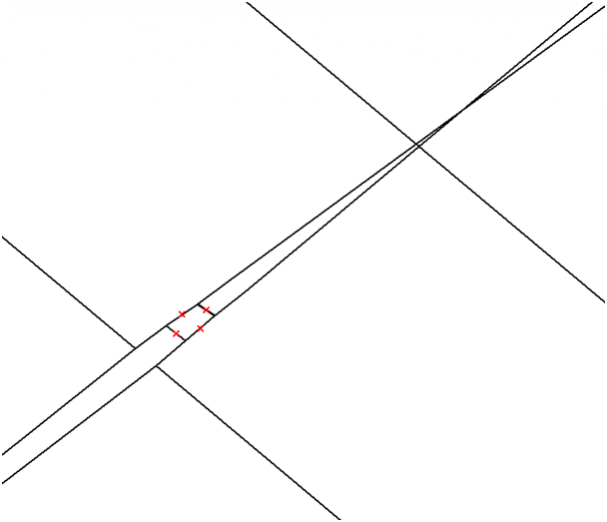
Fig. 27
The performance numbers can be seen in the table in Fig.28.

Fig. 28
Name of the MMANA file for this antenna is "all wires 7(2eL)-30MHz 75 Ohm LPA - Yagi Uda HYBRID to be installed @ RW9AW in Crimea M.maa". Vladimir RW9AW is now building the antenna. Will see the results in August 2020 from his Crimean residence.
I plan to write Part II of this article with description of construction details of said antennas.
Vladimir (Willy) Umanets UA9BA from Karataban of Chelyabinsk oblast May-June 2020
LPDA realistic design 088 75 Ohm
LPDA realistic design parasites


